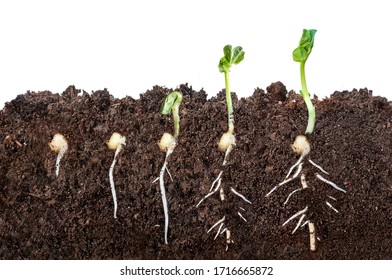
Factors affecting seed germination
- External or environmental factors
- Internal factors
External or environmental factors:
The seeds of all species essentially require at least three external conditions for germination. These four factors are –
- Water
- Suitable temperature
- Oxygen
- Light
1. Water
The supply of water is one of the essential requirements in the germination of seeds. Water is necessary for the physical and chemical processes that take place in the germinating seeds. With the imbibition of water, the seed coat becomes soft and permeable to water.
In their resulting state, seeds are characterized as low in moisture and relatively metabolically inactive. Water is also necessary for each germination stage, starting from imbibition, activating the enzyme, digestion of soluble complex food to soluble forms, and translocation to the assimilation into living protoplasm.
The amount and rate of water absorption depend upon the kinds of seed during germination and storage. The rate of water absorption increases with the increase of temperature. Soaking and steeping of seeds before planting are sometimes practices to enhance germination.
This practice is advantageous for seeds with hard or dry seed coats or with a dormant embryo. Excess water is harmful for seed germination as most of the seed can not respire under poor aeration conditions in a germination medium. Often, oversupply of water favors the damping off.
2. Suitable temperature
Temperature affects the absorption of water. The intake of oxygen and chemical reaction in germinating seeds. The temperature requirement for the seed germination is generally considered about three-point/There are 3 stages of temperature – minimum, maximum, and optimum. Minimum or maximum temperature below or above the seed germination does not occur. The largest number of seeds and particular species germinate at 26.5 – 36°C may be said as optimum temperature.
The non – dormant seed of small grains, clover, radish, onion, etc., germinate at very close to 20°C. Spinach seeds germinate at 10°C or very close to 20°C.
Freshly harvested seeds of cucumber and watermelon germinate at a high temperature of 30°C. Wheat seeds (slightly above 35°C) and maize seeds (5 – 45°C) germinate at a wide range of temperatures.
Commonly used practices are 15°C or 20°C for 16 – 18 hours and 30°C for 6 – 8 hours. The effect of alternating temperature on germination is called thermoperiodism.
3. Oxygen
Oxygen is an essential requirement in respiration which supplies energy to remain life by oxidation of foods. During germination, the oxidation rate increases.
C6H12O6 + 6O6= 6CO2 + 6H2O + 673 kCal energy
Oxygen uptake is increased, and Carbon dioxide is given off at an increased rate. Oxygen is responsible in some way regarding the initial reaction of germination.
Reduced aeration decrease the germination rate seeds of water plant and rice seed can usually germinate underwater. The ability of rice seed to germinate at low oxygen presence due to the presence of an anaerobic condition energy liberating system within the seeds.
4. Light
Visible light can stimulate or inhibit the germination of some plant species. Epiphytic plants have an essential requirement for light. While light inhibits the germination of some plant species, i.e., Allium amaranthus, etc. Light also favors the germination of lettuce, tobacco, and cauliflower.
Germination is controlled by a reversible photochemical reaction that involves a pigment’s response (Phytochrome) to the light of a specific wavelength.
in red light
Phytochrome Phytochrome (far red)
(Inhibits germination) (Promotes germination)
Imbibe seeds, when exposed to red light (wavelength 6400 – 6700 Å), the phytochrome (red) instantly changes to phytochrome (far red), which is associated in some way with inducing germination.
Internal factors:
The following internal factor plays a vital role for successful germination in the seed.
- Presence of auxin.
- Reserved food
- Completion of dormancy
- Viability of seed
1. Presence of auxin: During germination, a chemical called auxin develops in the seeds, which stimulates germination. In addition, to increase, another substance known as heteroauxin develops in some seeds. Both auxin and heteroauxin are called growth regulators.
2. Presence of reserved food: Foods are stored in the endosperm (monocot seed) or cotyledons (dicot seed). The embryo is dependent on the reserved food. Germination is possible if the seed can provide with necessary food to the embryo.
3. Completion of dormancy: Inhibit the growth of seed due to some internal causes even through the environmental condition available for germination is called dormancy. So during the dormant period of seed, complete breaking of dormancy must be essential.
4. Seed viability: Viability refers to the seeds whether a seed is alive, dormant, or dead. If the seed is not viable, it will not germinate.





No comments:
Post a Comment